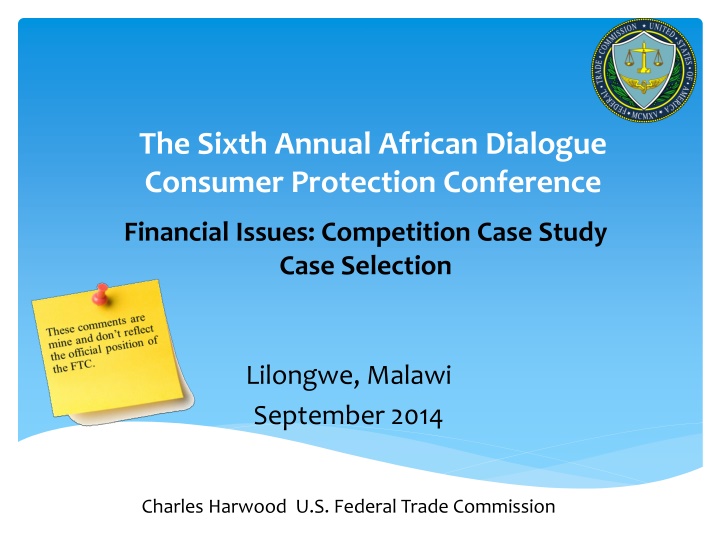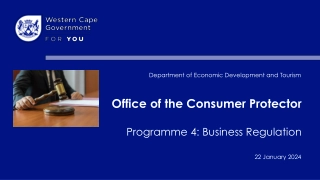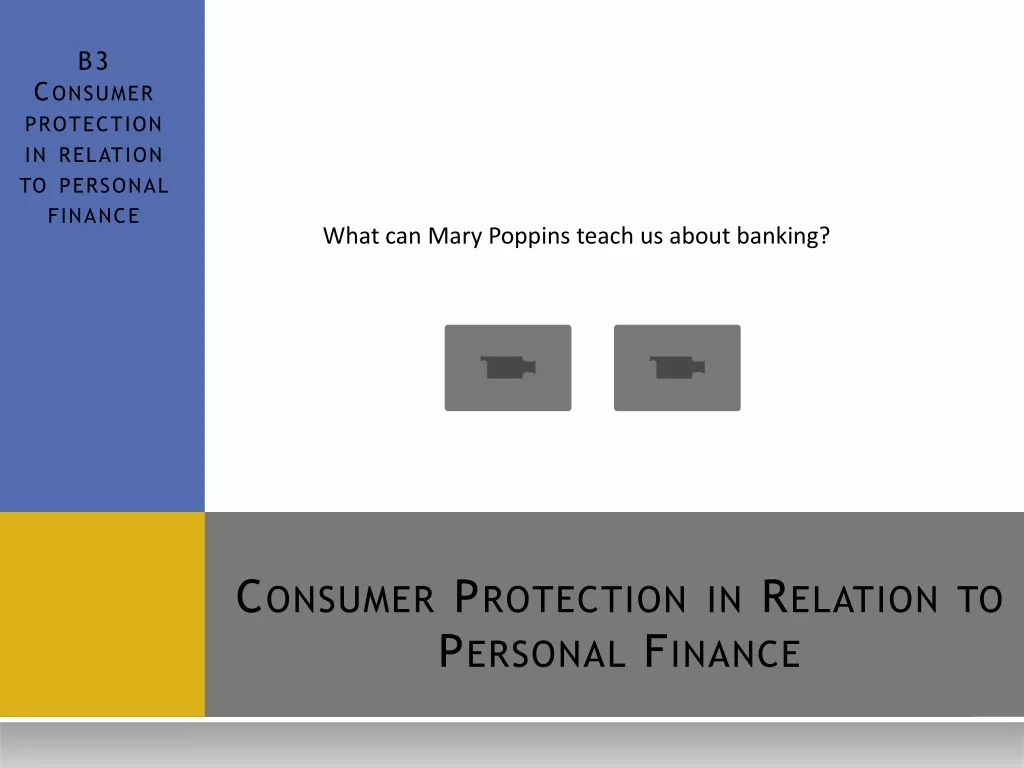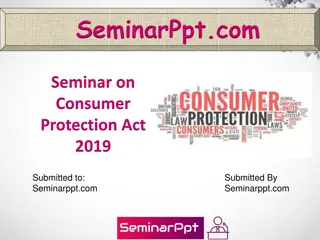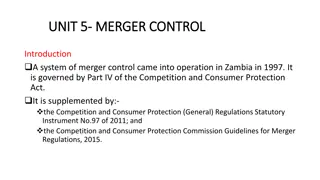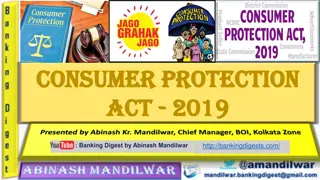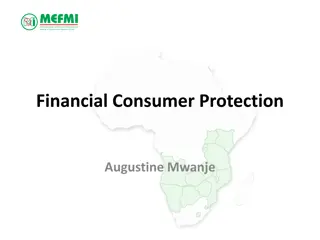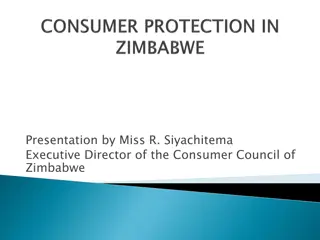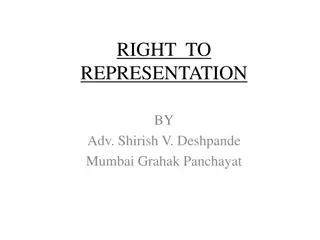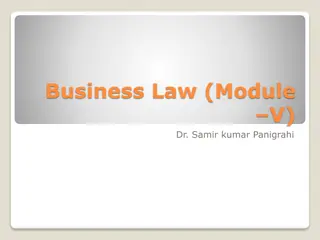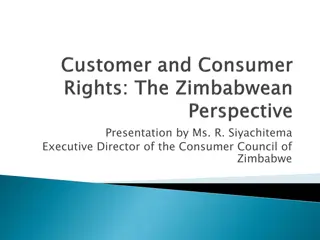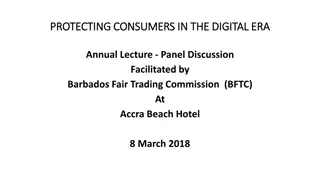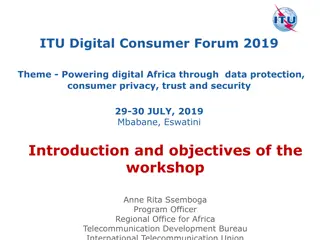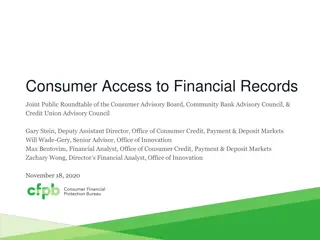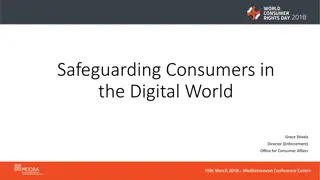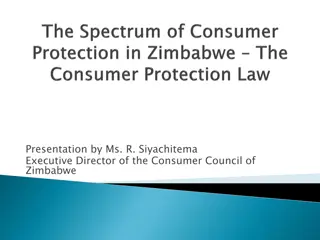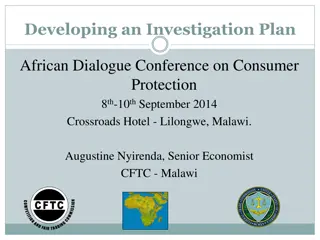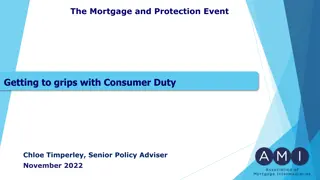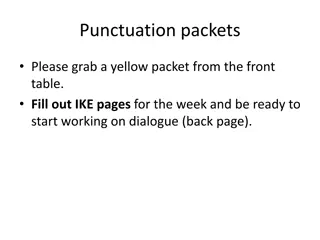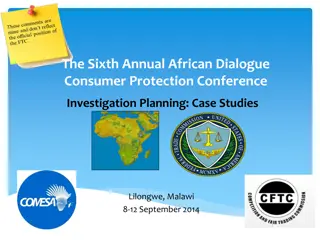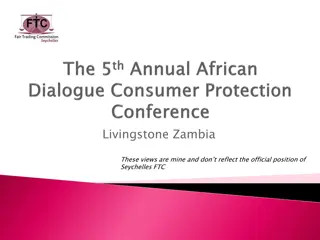African Dialogue Consumer Protection Conference Financial Issues
Assessing market power, case selection principles, international experience, merger thresholds, enforcement case selection, market power impact on consumers and competition, priority setting process, case selection criteria for consumer protection cases.
Download Presentation

Please find below an Image/Link to download the presentation.
The content on the website is provided AS IS for your information and personal use only. It may not be sold, licensed, or shared on other websites without obtaining consent from the author.If you encounter any issues during the download, it is possible that the publisher has removed the file from their server.
You are allowed to download the files provided on this website for personal or commercial use, subject to the condition that they are used lawfully. All files are the property of their respective owners.
The content on the website is provided AS IS for your information and personal use only. It may not be sold, licensed, or shared on other websites without obtaining consent from the author.
E N D
Presentation Transcript
The Sixth Annual African Dialogue Consumer Protection Conference Financial Issues: Competition Case Study Case Selection Lilongwe, Malawi September 2014 Charles Harwood U.S. Federal Trade Commission
Overview Assessing market power Case selection and prioritization Principles and objectives International experience Approaches to screening Merger thresholds Enforcement case selection
Market Power Able to keep prices above competitive levels without regard to competitors Illegal when obtained or maintained through anticompetitive means, which can result in: Higher prices for consumers Reduced output Reduced incentive to innovate BUT: market power obtained by offering a better product at a lower price is legal and encouraged: Success in the market through free and aggressive competition is encouraged Profits create incentives for incumbent and potential entrants to innovate, reduce prices, and improve service The problem: Vigorous competition and anticompetitive activity can look a lot alike!
Priority Setting: Principles and Objectives What? Process of deciding which activities (e.g. enforcement actions, advocacy initiatives, policy measures) to pursue in a given period of time, and in what order / priority Why? Enables an efficient allocation of the agency s scarce resources in order for it to meet its mandate and maximise the impact of its actions How? Set criteria / objectives Identify constraints Formulate (and communicate) a strategic plan
Case Selection: Criteria Direct economic impact? Cases / sectors that are economically significant and likely to have a direct impact on consumer welfare, in particular vulnerable consumers Precedent and profile? Low impact, test cases that nonetheless set important precedents Cases that raise the profile of the CA and promote compliance Probability of success / Availability of remedies? Cases where an infringement is likely to be found Cases where a sensible, workable solution is available Capacity building? Cases that develop the capabilities and knowledge of the CA Resource implications? Cases that are less resource and time intensive No one-size-fits-all approach to case selection and prioritization Priorities may need to shift over time Scope for the CA to select / prioritize cases may be constrained by legal and administrative duties
Case Selection: International Approaches Indonesia (a) sectors closely related to society s way of life; (b) highly concentrated industries; (c) markets where prices are highly sensitive; (d) public infrastructure and services South Africa Sectors and cases with particular impact on poor consumers (a) food and agro-processing; (b) infrastructure and construction; (c) intermediate industrial products; (d) banking Cartels a cross-cutting priority; capacity building and information gathering through merger analysis US (DOJ) Likelihood of finding a violation and whether the matter is significant (volume of commerce affected, geographic area impacted, impact of the investigation) UK (OFT) (a) direct and indirect effect on consumer welfare; (b) strategic significance of the work; (c) risks (the likelihood of a successful outcome); (d) resource implications France (a) likely outcome for CA, consumers and business; (b) balance between costs and benefits, including market impact; (c) strategic importance of sector for France and EU; (d) consistency with broader objectives of the CA; (e) information gathered through investigation; (f) public expectations Korea Eradication of cartels
Case Selection: Screening and Thresholds Priority setting and prioritization does not stop at case type/sector selection Screening (for example, through the application of notification thresholds), and phased evaluation processes a critical aspect of many CAs prioritisation and selection efforts Notification thresholds Should be clear and understandable, based on objectively quantifiable criteria (such as sales or assets, rather than market share) Based on information that is readily accessible to the merging parties Ideally, thresholds are set with a clear goal in mind, and are flexible
Case Prioritization: Merger Review Process Formal Notification Phase I Review Decision on Phase II Compliance with Information Requests Final Agency Decision REJECTION CLEARANCE
Collusion and Exclusionary Conduct Most competition laws address three generally recognized types of private anticompetitive conduct that hurt competition Anticompetitive mergers Collusion between competitors Exclusionary conduct by dominant firms Called monopolization in the United States Called abuse of dominance in most other places
Anticompetitive Agreements (Collusion) Many laws divide anticompetitive agreements between competitors into two groups: Agreements Judged by rule of reason May or may not be illegal depending on all of the facts and circumstances, including its purpose, any anticompetitive effects, any benefits from the agreement Agreements Illegal per se Purpose and effect are irrelevant These include cartels and other agreements that by nature almost always injure competition * Careful analysis may be needed to know which applies ANTICOMPETITIVE BUSINESS CONDUCT
Monopolization / Exclusionary Conduct Monopolization is illegal when a firm: Willfully acquires or maintains market power in a relevant market by means other than: superior product superior business acumen superior service good luck, or similar factors Monopolies are not illegal. Focus is on the exclusionary nature of the conduct. Some jurisdictions also address abuse of dominance, which also addresses how a dominant firm acts in the marketplace, even when dominance was legally obtained
Enforcement Case Selection Three-stage process Detection Screening / Initiation Investigation Detection: ideally a combination of proactive and reactive approaches Reactive methods driven by formal complaint systems and leniency policies Pro-active methods driven by market monitoring and tracking, agency cooperation, reviews of previous work, education and outreach Screening / initiation decision should ideally follow a phased approach (e.g. as per merger review process) Consider likelihood of success, complexity, resource intensity, impact
Case Study: A Merger of Money Wire Transfer Companies 13
Tangled Wires Facts 1/3 The acquiring firm is a wire remittance or money-transfer company called HurryMoney (Pty) Ltd. HurryMoney is based in Kenya and provides wire transfer services in Kenya, Rwanda, Somalia, Tanzania, and Uganda. It is currently the third largest provider in the region. The target firm is TimelyCash (Pty) Ltd, a wire remittance company that began operating in Rwanda, and expanded its operations to Tanzania, Uganda and the western region of Kenya. It is the fourth largest provider in this region. HurryMoney and TimelyCash primarily offer person-to-person money transfers and household utility payments to individuals through a network of local agents and local financial institutions. 14
Tangled Wires Exhibit A 15
Tangled Wires Facts 2/3 HurryMoney operates 156 outlets scattered throughout all five counties. It takes a 10% commission from each transfer. HurryMoney also charges a conversion fee for currency changes from the Kenyan Shilling. TimelyCash owns a total 128 outlets throughout four countries. The rate to send any denomination is a fate fee of $2076 Rwandan Franc (~$3 USD) or the equivalent amount in each country. There are no additional charges for converting currencies. Additionally, the TimelyCash collaborated with Tigo, a regional mobile company, to offer peer-to-peer transfers via mobile phones and the internet at the same flat rate. The merging parties signed a definitive purchase agreement. They will notify the appropriate competition authorities that require or request a merger filing. 16
Tangled Wires Facts 3/3 The parties submit merger notification filings with the appropriate competition authorities in the overlapping countries and provided the following rationale for the transaction: HurryMoney wants to increase its presence within its core countries to remain competitive with large wire transfer companies and low cost remittance services offered by banks. The proposed transaction will increase the number of regional outlets that provide cheap and rapid wire remittances for many individuals. The TimelyCash business will allow HurryMoney to expand into the online and mobile remittance platforms. Many banks are abandoning their low-cost remittance services which will allow HurryMoney and TimelyCash to capture additional business from former bank customers. 17
Does this Warrant In-depth Review? The main goal in the initial phase is to determine quickly whether to conduct an in-depth review If no obvious competitive concerns, no formal plan required Quick review of notification filing or public data may suffice Goal is to clear transaction quickly If concerns raised by preliminary review, then develop and initial investigation plan Initial phase should focus on extent to which further investigation is required Can often be focussed to a single threshold issue Focus on a few discrete tasks and, where appropriate, limited information requests, calls and/or meetings Timing is critical; as are other constraints and priorities: both internal and external See ICN Investigative Techniques Handbook for Merger Review
Reviewing Notification Information Administrative requirements Identification of the parties to the transaction Verification of a notifiable transaction Description of the transaction Nature of the transaction; ownership and control before and after Explanation of the business rationale Timing of consummation Transaction documents Information on the parties What businesses do the parties own and operate Corporate structure: shareholders, subsidiaries, affiliates Recent financial statements & annual reports Competitive analysis information Parties assessment of the relevant markets where their services overlap and their calculations of market shares
Questions for the Merging Parties Learn each party s view on antitrust issues What is the rationale for the conduct Have the parties business people educate you Talk to the marketing people or the person that can tell you how prices are set or negotiated Ask the target to back it up. Obtain key ordinary course of business document such as Strategic and business plans Studies Board presentations on conduct, particularly those describing any synergies Pricing plans Test competitive concerns by disclosing them to the target The disclosure will help you to learn the evidence and arguments that you will need to overcome in any challenge 20
Questions for Competitors Learn from competitors Product offerings and overlaps How companies compete on price on services? What new innovation have emerged? Competitive conditions What is the current market structure? What is the draw/service area size? What are the technological trends and historical events? What are the market shares? Entry What are the entry conditions, i.e., investment costs, government approvals and licensing regulations, marketing expenses, etc.? 21
Interview Questions for Customers Learn from customers The number and strength of competitors Are the parties services viewed as close substitutes? What substitutes are available? Do they have any concerns? Are there anecdotes of past competition issues? 22
Questions for Discussion Using information from interviews and obtained from the parties, determine whether the available information suggest there are issues that pose a potential competitive problem: What is the relevant product market? The relevant product market is low-cost wire remittance services sent from person-to- person. What is the relevant geographic market? How wide is the service area for each outlet? The four countries in which the parties businesses overlap are each a separate geographic market. The service area for each outlet is about 6 kilometers. Most TimelyCash outlets are located within 6 kilometers of a HurryMoney outlet. 23
Questions for Discussion Using information from interviews and obtained from the parties, determine whether the available information suggest there are issues that pose a potential competitive problem: Identify which companies compete with the parties to provide the same services to the same customers. How many other significant competitors are in the geographic market? How close are other competitors in proximity to each party s outlets? How much market share does each competitor have? Within each country/geographic market, the parties face the same competitors and each competitor has the same market share based on their 2013 revenue. If the relevant product market is restricted to low-cost wire remittance service providers, the market share allocation is as follows: - the largest regional provider is WesternGram plc with 40 percent; - the second largest provider is Equity Bank, a regional bank with 24 percent; - HurryMoney is the third largest with 15.6 percent; - TimelyCash is the fourth largest with 12.8 percent; and - the two remaining competitors that mainly perform remittance services over mobile and internet platforms, each have 3.8 percent of the market. 24
Questions for Discussion Using information from interviews and obtained from the parties, determine whether the available information suggest there are issues that pose a potential competitive problem: Is there any information that rules out a potential for a competitive problem, such as a low barriers to entry? Barriers to entry in low-cost wire transfer services are high due to the cost of purchasing and operating multiple outlets. However, two entrants have emerged in the market within the passed two years by primarily offering peer-to-peer transfers via mobile phones and the internet which is rapidly growing in popularity. Is there any other significant market information? The merged entity will have a post-merger share of less than 30 percent and likely will be constrained by only 1 other wire remittance company. Equity Bank has announced that it plans to abandon its low cost remittance services. 25
Managing the Investigation and Evidence Organize the Information Develop an investigation plan that organizes case information (by product or by issue) Consider how technology may help you be more efficient Maintain Communications Keep an Open Dialogue with Merging Parties commit to regular opportunities to discuss progress Initiate a Dialogue with Third Parties can provide crucial fact information and perspectives on the merger Keep decision makers informed Discuss impasses with the parties Discuss possible remedies 26
Managing the Investigation and Evidence Organizing Information Set out a summary description of the transaction HurryMoney, a regional wire remittance company offering peer-to-peer money transfers in over 150 outlets in five countries, proposes to acquire TimelyCash, a regional wire remittance company with over 120 outlets in four countries and mobile and internet transfer capabilities. Distil the reason(s) to investigate further Merger would combine the #3 and #4 providers in Kenya, Rwanda, Uganda, and Tanzania. No overlap identified in Somalia. Banks that do not offer low-cost services to individuals can be excluded Develop a working theory of harm (and, if appropriate, remedies to be sought) Merged firm could charge higher prices to customers in four countries (and/or otherwise degrade their service) if the parties are particularly close competitors, and could control a substantial share of sales in a well-defined narrow market for low-cost wire transfers in each country, and if price increases would not be defeated by entry and/or expansion into that market. Merged firm could coordinate with WesternGram and other competitors to charge higher prices for services. 27
Managing the Investigation and Evidence Organizing Information Identify the key factual issues to be resolved Geographic market Is an entire country as a relevant geographic market too large or small? Closeness of competition How do customers view the providers? Entry / Expansion / Exit Are mobile and internet remittance platforms viable innovations? How should the entry of two new wireless transfer companies be evaluated? How will the exit of the regional bank from the market affect competition? Remedies Divestitures of problematic overlapping outlets 28
